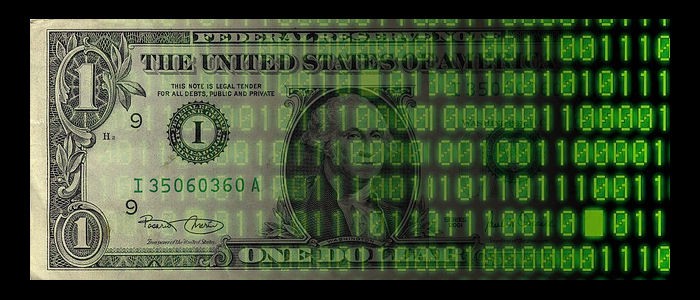Before the bitcoins (part I of II)

A brief history of digital currency: from barter to DigiCash.
In the beginning there was the transaction.
From the day the first Homo sapiens (Homo neanderthalensis?) gave up their flint tools in exchange for pieces of amber owned by their neighbour sapiens, the exchange process began. Since then, we’ve never looked back. What happened on that distant day tens or hundreds of thousands of years ago was a transaction, both in its definition as an agreement between two parties as well as a commercial operation.
The first system we used was barter: the direct exchange of objects for other objects; services in exchange for objects or other services. This system was simple and came naturally, ideal in small communities which only had a few goods to exchange.
One of the limits of this exchange operation is that the needs of the two bartering parties had to coincide; if Isolde wants to exchange her spun fabric for one of Tristan’s amphoras, the prerequisite would be for Tristan to need that fabric. But if Tristan requires medicine instead, Isolde will then have to look for someone who has that medicine and will give it to her in exchange for her fabric.
In the absence of communication and coordination, bartering can be inefficient. [1]
Much later in human history, two other systems were developed: one based on money, the other one on credit.
With the advent of coins, numerical values were given to goods. This began our definition of common standards, establishing a method of payment and a store of value, thereby creating a market allocation system: prices.
The first coins were goods — “commodities” or “collectibles” — such as shells, salt or livestock: otherwise known as natural currency, or commodity currency. Only later did the use of coins made from precious metals spread, but both types of coins had characteristics in common: they were transportable, difficult to falsify and easy to evaluate. At the end of the day, the ultimate function of coins was in its means of the storage and transference of wealth (Szabo, 2005).
A credit-based system then introduced the promise of payment in the form of a written document. Banknotes are an example of this, being bearer debt securities. Designed by the Chinese, this system was subsequently adopted as an integral part of the economic market by Florentine and Flemish bankers.
Both systems come with their disadvantages: coins are risky to carry, and debt securities are at risk of default, given that the “promise” they’re based on may not be maintained. Despite these disadvantages, however, for centuries these have been the pillars of global trade.
In particular, cash — coins and banknotes — offer several positive aspects: the main advantage of physical money is that whoever possesses the physical object is automatically the owner of the unit of value. Moreover, transactions can be anonymous (between a seller and a buyer there is no need to know each other’s identities) and carried out without the involvement of a third party (Aleksander Berentsen, 2018), aspects we will come back to when dealing with the basic characteristics of cryptocurrencies.
Amongst the many “inventions” in our history that have characterized the economic and commercial sector, the credit card is often mentioned, first appearing in the United States in its modern form in 1950. Its appearance is important for two reasons: firstly, it is an example of a deferred payment system guaranteed by a third party (the credit card company) and, decades later, it would become the first form of payment used on the Internet.
The Net Age
The birth of a global digital communication channel, such as the Internet and later, the web, quickly made the world a much smaller place full of opportunities, especially of a commercial kind.
In the early ’90s, merchants experimented with the first instances of online sales. The credit card was the tool that best suited this new medium. Surrendering credit card details to a stranger via email, however, was viewed by some as being a display of equal parts bravery and stupidity.
Thus began the first steps towards higher security in digital transactions. There was a need to have reliable intermediaries between the seller and the buyer, especially for the management of credit card data during the transaction. One of the first attempts was made by a company called First Virtual. Transactions took place via email without the sharing of card details, but credit transfers to sellers could take months.
In the middle of that decade, major credit card networks such as Visa and MasterCard also faced the problem of online payments. Together with ICT giants such as IBM, Microsoft and Netscape, they created a standard called SET (Security Electronic Transaction) which allowed the encrypted sending of data via browser to an intermediary, the only one who could decrypt them and authorize the payment. One of these services was CyberCash, who also created the first electronic currency, CyberCoin, suitable for micropayments.
Let’s go back for a moment to one of cash’s main benefits: anonymity. One question we’ve raised since the beginning of the Internet has been: is it possible to create a digital equivalent of cash? The problem with digital objects, like files, is that they are easily duplicated. If a digital currency were duplicable, therein would lie the problem of double-spending: the same currency could be spent several times. Now, you could try to solve the problem by entering a serial code associated with each coin, storing the list of codes associated with the owner in a server. But in doing so, you would lose anonymity.
Towards the end of the ’80s/early ’90s, the birth of the Internet and new communication technologies (such as mobile devices) favored the emergence of the techno-libertarian cypherpunk movement (in the wake of cyberpunk), which was obsessed with the privacy and anonymity that would guarantee protection from the nascent digital Big Brother.
In 1992, in an encrypted mailing list of the movement, one of its exponents, Hal Finney (who we’ll come back to in part 2), wrote:
“Here we are faced with the problems of loss of privacy, creeping computerization, huge databases, greater centralization — Chaum (DigiCash) offers a completely different direction, puts power in the hands of individuals rather than governments and companies: the computer can be used as a tool to free and protect people, rather than to control them.”
Centomo, 2017
Who’s Chaum? David Chaum is a computer scientist who has always looked for ways to give the digital world complete anonymity. In 1979 he had already introduced the concept of “mix network”: a network in which each node acts and “mixes” messages in transit, already encrypted, to make traceability difficult — a concept that would come to be used by anonymous communication systems such as Tor and the Bitcoin architecture itself. But Chaum didn’t stop there.
In 1982, Chaum introduced the concept of blind signatures (Chaum, 2011), in which a message is “signed” via a public/private key cryptography system — without the need for information on the message itself — guaranteeing anonymity. In 1990 he founded DigiCash, where he put his theory into practice through inventing, essentially, the first-ever system for online payments. He also patented the blind signature, severely limiting experiments. But a group of cryptographers created a “hacked” version of this proto-digital currency, called MagicMoney.
Unfortunately, DigiCash did not achieve the success it’d hoped for, since it never reached the critical mass of sellers necessary to accept this payment system.
There was also a fundamental problem linked to the concept of digital currencies: they were not autonomous — that is, detached from real currencies such as the dollar and their fluctuations directly caused by the economic-financial system detested by most of the experimenters of that period (and the periods that would follow).
Furthermore, in order to create a currency that has value, it must be a scarcity; an asset not easily obtainable.
Strangely enough, the idea of ‘artificially’ making it difficult to counterfeit the minting of digital coins came from spam emails, or rather, the need to impede their circulation. In 1992, seeking to tackle this problem, cryptographers Dwork and Naor proposed that, before a user sent an email, his computer had to solve a mathematical puzzle that kept it busy for a few seconds — little harm to regular users who didn’t send many emails, much hassle to spammers trying to send thousands of emails. Upon solving the puzzle, a “proof of resolution” would be attached to the email. Without it, an email would be rejected by its recipient. The first proof of work was hence created, eventually becoming an algorithmic pillar of Bitcoin. The concept of the mathematical puzzle applied to emails was also used by Adam Back in 1997, on his algorithm Hashcash.
Slowly but surely, the idea of an autonomous digital currency materialized.
One other contributing key component was theorized by Haber and Stornetta in 1991. They proposed a system for affixing a reliable timestamp to an electronic document. A server would take care of inserting this timestamp in the file as a signature and a link to the previous “certified” document. This idea of a logical sequence, of a chain of digital documents, was starting to catch on.
From here, two crucial ingredients for the creation of a currency came together: a timestamp system and the proof-of-work concept, the union of which would make an otherwise simple operation computationally expensive.
Stay tuned for part 2, where we will move on to another important element: cryptography.
Notes
[1] Bartering still exists in different forms, in the digital and non-digital world. After all, isn’t the exchange of gifts at Christmas a sort of barter?
References
Guide to cryprocurrency “Cryptocurrency Trading 2021: Everything You Need To Know To Start Today”, 2021: https://commodity.com/cryptocurrency/
Aleksander Berentsen, F. S. (2018). A Short Introduction to the World of Cryptocurrencies. Retrieved 03 07, 2018, from Federal Reserve Bank of St. Louis: https://files.stlouisfed.org/files/htdocs/publications/review/2018/01/10/a-short-introduction-to-the-world-of-cryptocurrencies.pdf
Camp, L. J. (2001). First Virtual. In L. J. Camp, Trust and Risk in Internet Commerce (pp. 209–214). Cambridge: The MIT Press.
Centomo, M. (2017, 12 24). I Cypherpunks: da David Chaum a Satoshi Nakamoto. Retrieved 03 08, 2018, from next-generation currency: https://nextgenerationcurrency.com/cypherpunk-david-chaum-satoshi-nakamoto/
Chaum, D. (2011, 06 07). Blind Signatures for Untraceable Payments. Retrieved 03 09, 2018, from the Isoblog: http://blog.koehntopp.de/uploads/Chaum.BlindSigForPayment.1982.PDF
Dai, W. (1998). bmoney. Retrieved 03 19, 2018, from weidai.com: http://www.weidai.com/bmoney.txt
Davies, G. (2002). A History of Money — From Ancient Times to the Present Day. Cardiff: University of Wales Press. Retrieved from http://library.uniteddiversity.coop/Money_and_Economics/A_History_of_Money-From_Ancient_Times_to_the_Present_Day.pdf
Finney, H. (2004). RPOW Security. Retrieved 03 20, 2018, from Satoshi Nakamoto Institute: http://nakamotoinstitute.org/finney/rpow/security.html
Genesis block. (2017, 11 30). Retrieved 02 19, 2018, from Bitcoinwiki: https://en.bitcoin.it/wiki/Genesis_block
Greenberg, A. (2016, 06 01). The Father of Online Anonymity Has a Plan to End the Crypto War. Retrieved 03 09, 2018, from Wired: https://www.wired.com/2016/01/david-chaum-father-of-online-anonymity-plan-to-end-the-crypto-wars/
May, T. C. (1992, 11 26). The Crypto Anarchist Manifesto. Retrieved 03 19, 2018, from activism.net: https://www.activism.net/cypherpunk/crypto-anarchy.html
Miccoli, M. (1998, 07 20). Ora anche gli spiccioli viaggiano su Internet. Retrieved 03 08, 2018, from repubblica.it: http://www.repubblica.it/online/internet/spiccioli/spiccioli/spiccioli.html
Moneta. (2018, 02 21). Retrieved 03 06, 2018, from Wikipedia: https://it.wikipedia.org/wiki/Moneta
Peck, M. E. (2012, 05 30). Bitcoin: The Cryptoanarchists’ Answer to Cash. Retrieved 03 19, 2018, from spectrum.ieee.org: https://spectrum.ieee.org/computing/software/bitcoin-the-cryptoanarchists-answer-to-cash
Russel, R. (2003). La crittografia. In R. Russel, Hack Proofing (pp. 163–204). Milano: McGraw-Hill.
Stuart Haber, W. S. (1991). How to Time-Stamp a Digital Document. Cryptology, 3, pp. 99–111. doi:https://doi.org/10.1007/BF00196791
Szabo, N. (2005). Shelling Out. The Origins of Money. Retrieved 03 20, 2018, from Phonetic Sciences — University of Amsterdam: http://www.fon.hum.uva.nl/rob/Courses/InformationInSpeech/CDROM/Literature/LOTwinter




